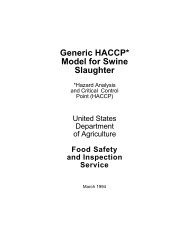Generic HACCP Model for Thermally Processed Commercial
Generic HACCP Model for Thermally Processed Commercial
Generic HACCP Model for Thermally Processed Commercial
You also want an ePaper? Increase the reach of your titles
YUMPU automatically turns print PDFs into web optimized ePapers that Google loves.
Now you are ready to develop your plant-specific <strong>HACCP</strong> plan(s) according to the<br />
procedures shown in the generic process model(s).<br />
<strong>Model</strong> Plan <strong>for</strong> <strong>Thermally</strong> <strong>Processed</strong>/<strong>Commercial</strong>ly Sterile<br />
Hazard Analysis<br />
Conducting an analysis of the physical, chemical, and biological hazards associated with<br />
a process is a critical first step in the effective development and implementation of the plantspecific<br />
<strong>HACCP</strong> plan. The in<strong>for</strong>mation gathered should focus on addressing points of public<br />
health significance associated with the manufacture of those products by a particular process used<br />
in your plant. The hazard analysis must be conducted as a starting point in the development<br />
of the plant-specific plan. In<strong>for</strong>mation <strong>for</strong> a hazard analysis can be obtained from a local<br />
public library, community college or university library, the extension service, scientific<br />
publications, FDA guidelines, USDA Guidebook <strong>for</strong> the Preparation of <strong>HACCP</strong> Plans and<br />
Meat and Poultry Products Hazards and Control Guide, or other sources that are available<br />
to the general public. It is important to include as much in<strong>for</strong>mation as possible relevant<br />
to the public health hazards associated with your process, including in<strong>for</strong>mation on<br />
suppliers per<strong>for</strong>mance at meeting public health related specifications, in-plant incidents<br />
of contamination or adulteration, and product recalls. This will ensure that process hazards<br />
are recognizable as you proceed through the remaining steps of creating the plant-specific<br />
<strong>HACCP</strong> plan. An example of in<strong>for</strong>mation needed <strong>for</strong> an analysis of the hazards associated with<br />
a specific process follows on the next few pages. Included along with this in<strong>for</strong>mation should be<br />
your experience with, and knowledge of the process, and how it occurs in your plant.<br />
There are a few important aspects to note when reviewing the in<strong>for</strong>mation over the next<br />
few pages. Every establishment should validate the <strong>HACCP</strong> plans adequacy in controlling the<br />
food safety hazards identified during the hazard analysis, and should verify that the plan is being<br />
effectively implemented. Each establishment should maintain records documenting the<br />
establishment’s <strong>HACCP</strong> Plan, including references to all supporting documentation.<br />
Epidemiological in<strong>for</strong>mation is used to assess the public health significance of the known<br />
hazards associated with the specific process. These include the types and severity of diseases and<br />
injury caused by the occurrence of microbiological, physical, and chemical contamination. It also<br />
will assist you when you are ready to use the decision tree to determine<br />
the validity, existence, and appropriateness of a critical control point. This in<strong>for</strong>mation can aid<br />
in determining a significant hazard from an insignificant one based on the frequency, severity,<br />
and other aspects of the risk.<br />
The biological, chemical, or physical hazard in<strong>for</strong>mation gathered will aid in determining<br />
where a hazard may occur in the process, what could cause the hazard, how it can<br />
9



